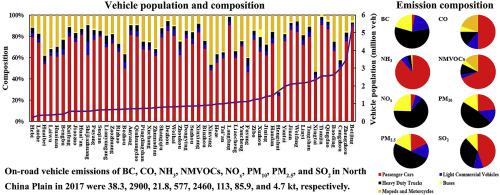Environmental Pollution ( IF 8.9 ) Pub Date : 2020-09-11 , DOI: 10.1016/j.envpol.2020.115639 Peiyu Jiang , Xi Zhong , Lingyu Li

|
Vehicle emissions are a major contributor to air pollution in China. In this study, a high-resolution inventory of eight on-road vehicle-emitted pollutants in 53 cities within the North China Plain (NCP) was established for 152 sub-sources. Monthly emission factors were then simulated using the COPERT v5 model and their spatial distribution at 4 km × 4 km resolution was allocated based on the transportation network. In 2017, emissions of BC, CO, NH3, NMVOCs, NOx, PM10, PM2.5, and SO2 were 38.3, 2900, 21.8, 578, 2460, 113, 85.9, and 4.7 kt, respectively. These emissions and their sources differed between cities, mainly due to different vehicle populations, fleet compositions, emission share rates of different vehicle types, and emission standards in each city. Small-medium petrol passenger cars and both 20–26 t and 40–50 t heavy-duty diesel trucks of China 3 and 4 emissions standards were the main contributors for all pollutants. Higher cold-start emission factors caused higher emissions of CO, NMVOCs, NOx, and PM2.5 in winter. The cities of Beijing, Zhengzhou, Tianjin, Tangshan, Xuzhou, Qingdao, Jinan, Jining, and Zibo had the highest emission intensities. Overall, emissions decreased from the city centers toward surrounding areas. The higher contributions of heavy-duty trucks meant that higher emissions appeared along highways in a vein-like distribution. These results provide a theoretical basis for the effective prevention and control of air pollution in the NCP.


























 京公网安备 11010802027423号
京公网安备 11010802027423号